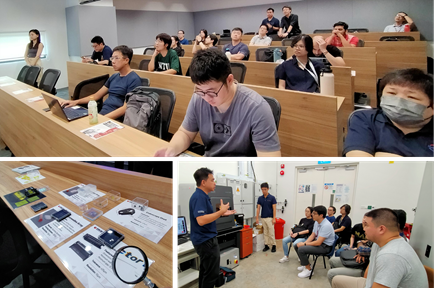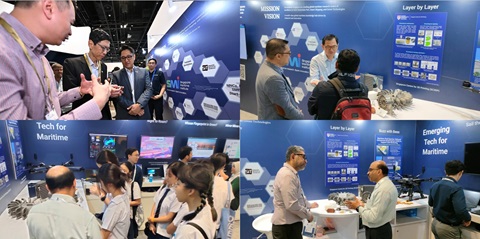3D printing rocks for teaching – a collaboration with the Asian School of the Environment (ASE)
Overseas field courses are an integral part of the Asian School of the Environment’s undergraduate programmes, but the Covid-19 pandemic put a stop to most forms of international travel. Instead, the instructors at ASE had the novel idea to recreate this field experience within the campus through 3D printing. Assoc Prof Benoit Taisne from ASE initiated a collaboration with the Singapore Centre for 3D Printing’s (SC3DP) Building and Construction (B&C) programme to design and 3D print a rock model that can be used as an educational tool for ASE’s experiential geoscience classes.
Real rocks in the field have a range of subtle details. In this case, the rock model needs to have dipping planes. As such, the research team had to carefully consider the relatively low resolution of concrete and the design of robotic paths to produce the needed details. Assoc Prof Wong Teck Neng and his team successfully printed an impressive rock model weighing approximately 1200 kg. The rock model comprises of several unique modular blocks stacked together on a centre column. These blocks include a slanting bottom, a slanting top, and several aligned middle blocks. The various indentations on the lateral sides of the blocks are spliced together to mimic the texture of natural rocks. This design allows for the modular blocks to be rotated so that new batches of students would have their own unique experience and results from studying the rock model. The façade design and inner structure were optimised to maximise the indentation variations and reduce the block weight.
/3d-printed-rock-model-1b93c4372-a43b-438f-8353-e59bbc2c3e45.png?Status=Master&sfvrsn=26c1a032_3)
Image credit (left): Jeong Moon Young
While the indentations between blocks can be large, the maximum indentation inside one block is limited by material property and printing parameters. To ensure that there is sufficient raw material amidst global supply chain uncertainties, the team also invented a new 3D printable concrete recipe, mainly composed of off-the-shelf products available locally in the Singapore market. The printing parameters were optimised to utilise the material’s properties to get the maximum indentations inside one block. Since the design contains two slanting blocks, the inner printing path was also optimised to ensure that these two blocks can be successfully printed without collapsing.
/ase-collab-26386e7af-ef04-4314-a3e8-a7298f287f4d.png?Status=Master&sfvrsn=98c420f6_3)
Photo credits: Assoc Prof Benoit Taisne
In May and June 2021, students from the ES1006 Introductory Field Experience course learnt the geological concept of “Strike and Dip” using the 3D printed rock model. This collaboration between ASE and SC3DP within NTU is an example of interdisciplinary exploration to tackle unexpected challenges.
Special thanks to the Asian School of the Environment, Jeong Moon Young, Li Mingyang, Weng Yiwei, Lee Wei Kit, Dr Anna Lagerstroem, Prof Wong Teck Neng and Prof Benoit Taisne for their contributions to the article.
For more information
- Read ASE’s new release
- Watch a time-lapse of the 3D printing process of the rock model on ASE’s Facebook







